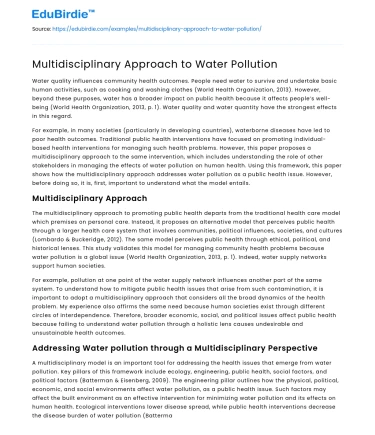Water quality influences community health outcomes. People need water to survive and undertake basic human activities, such as cooking and washing clothes (World Health Organization, 2013). However, beyond these purposes, water has a broader impact on public health because it affects people’s well-being (World Health Organization, 2013, p. 1). Water quality and water quantity have the strongest effects in this regard.
For example, in many societies (particularly in developing countries), waterborne diseases have led to poor health outcomes. Traditional public health interventions have focused on promoting individual-based health interventions for managing such health problems. However, this paper proposes a multidisciplinary approach to the same intervention, which includes understanding the role of other stakeholders in managing the effects of water pollution on human health. Using this framework, this paper shows how the multidisciplinary approach addresses water pollution as a public health issue. However, before doing so, it is, first, important to understand what the model entails.
Save your time!
We can take care of your essay
- Proper editing and formatting
- Free revision, title page, and bibliography
- Flexible prices and money-back guarantee
Multidisciplinary Approach
The multidisciplinary approach to promoting public health departs from the traditional health care model which premises on personal care. Instead, it proposes an alternative model that perceives public health through a larger health care system that involves communities, political influences, societies, and cultures (Lombardo & Buckeridge, 2012). The same model perceives public health through ethical, political, and historical lenses. This study validates this model for managing community health problems because water pollution is a global issue (World Health Organization, 2013, p. 1). Indeed, water supply networks support human societies.
For example, pollution at one point of the water supply network influences another part of the same system. To understand how to mitigate public health issues that arise from such contamination, it is important to adopt a multidisciplinary approach that considers all the broad dynamics of the health problem. My experience also affirms the same need because human societies exist through different circles of interdependence. Therefore, broader economic, social, and political issues affect public health because failing to understand water pollution through a holistic lens causes undesirable and unsustainable health outcomes.
Addressing Water pollution through a Multidisciplinary Perspective
A multidisciplinary model is an important tool for addressing the health issues that emerge from water pollution. Key pillars of this framework include ecology, engineering, public health, social factors, and political factors (Batterman & Eisenberg, 2009). The engineering pillar outlines how the physical, political, economic, and social environments affect water pollution, as a public health issue. Such factors may affect the built environment as an effective intervention for minimizing water pollution and its effects on human health. Ecological interventions lower disease spread, while public health interventions decrease the disease burden of water pollution (Batterman & Eisenberg, 2009).
Lastly, social and political interventions introduce policy and infrastructural developments in addressing the health issue. Experts have used this multidisciplinary approach to control water pollution in Zaria city, Nigeria (Batterman & Eisenberg, 2009). It has shown remarkable success.
Conclusion
There is a need for introducing fundamental changes to how we address water pollution, as a public health issue. Adopting a multidisciplinary approach is at the center of such changes because it provides a dynamic understanding of the public health issue. This approach integrates data and methods for solving public health concerns. Furthermore, it provides a framework for tracking water pollution and evaluating how its short-term and long-term indicators affect public health services when managing the associated health problems.






 Stuck on your essay?
Stuck on your essay?

